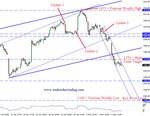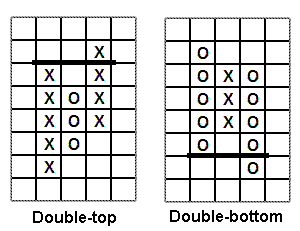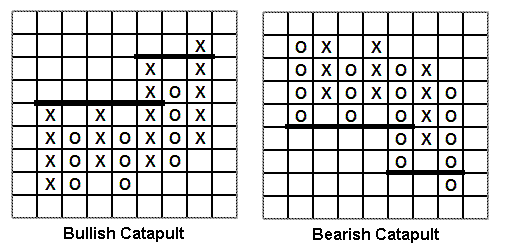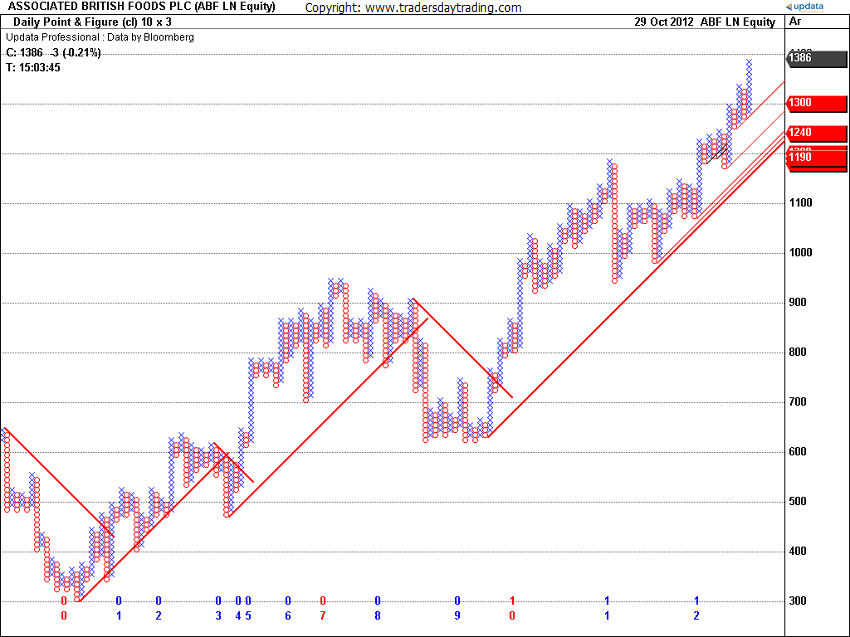Understanding
Point and Figure Charts
By Jeremy du Plessis CMT FSTA
Understanding Point and Figure Charts: Part 2
Modern
computer-drawn Point and Figure charts are constructed in a variety of
ways using a variety of time-series data. For medium to
long-term analysis, either the high/low method or the close method is
used with end-of-day data. The availability intraday
time-series data means that shorter-term charts may be constructed
using the close or high/low at the end of every minute or every hour or
in fact any intraday time frame. The result is that the Point
and Figure method can be used for all time frames and time horizons.
What is important to understand is that the time horizon of a Point and
Figure chart depends not only on the underlying data being used, but
also on the box size. The time horizon of the chart can be
altered without changing the underlying data by varying the box
size. The smaller the box size, the more sensitive the chart
to price movements and consequently the shorter the time horizon.
Typically, a Point and Figure analyst will look at
two, perhaps three Point and Figure charts of the same instrument but
with different box sizes to obtain a clearer picture of what is
happening.
|
|
Point and Figure Charting
Contents Index
Related Pages
|
Point and Figure Charts Explained
Point and Figure construction on a squared grid, with data placed into
boxes, allows objective application of tools and therefore objective
analysis.
3-Box reversal charts, more so than 1-box, are best
used for this objective application and analysis making them a
favourite amongst Point and Figure chart users.
The interpretation of 3-box charts is more objective because the
patterns are more defined with fewer variations than those in 1-box
charts, consequently chart
patterns can be uniquely identified.
Essentially all signals from 3-box Point and Figure charts are based
on breakouts.
|
Kennys Technical Analysis

Kennys Elliott Wave Analysis is my trading plan for
the week ahead with regular updates.
Technical analysis reports using
Elliott waves, chart patterns, trend trading strategies, Hurst cycles
and other stock market
time cycles analysis.
Kennys
Elliott Wave Analysis |
Understanding Point and Figure Charts
A basic Point and Figure buy signal occurs when a column of Xs rises
above the previous column of Xs, called a double-top buy; a sell occurs
when a column of Os falls below the previous column of Os, called a
double-bottom sell. Figure 3 shows these two basic Point and
Figure patterns.
 Figure
3 P&F Chart Double-top and Double-bottom Patterns
Figure
3 P&F Chart Double-top and Double-bottom Patterns
The strength of any Point and Figure pattern depends on the pattern’s
width. The more columns it takes before the breakout, the
stronger the subsequent signal. So a triple-top or
triple-bottom leads to a stronger signal than the double equivalent.
In all Point and Figure pattern analysis, reassertion of control is
important for determining pattern strength. This occurs when
a pattern switches from being bullish to bearish and back to bullish
again. The most common example is the catapult pattern, where
there is firstly a triple-top breakout, followed by a pullback into the
pattern which is then reversed resulting in a double-top
breakout. The converse is true for sell
patterns. The fact that, in spite of being rebuffed, a group
can regain control is important for the pattern’s strength.
See Figure 4 for the bullish and bearish versions of the catapult.
 Figure
4 Point and Figure Chart Bullish and bearish Catapults
Figure
4 Point and Figure Chart Bullish and bearish Catapults
Many other Point and
Figure patterns have been indentified and named. Not every
breakout is
taken as a buy or sell. Point and Figure analysts look to see
if it is
part of a bigger pattern, but also they take note of trend lines.
Understanding Point and Figure Charts: Trend Lines
The
way trend lines are drawn and used is another advantage of
3-box reversal charts. Unlike trend lines on bar, line and
candle charts which must be positioned subjectively, the Point and
Figure squared grid allows trend lines to be drawn at a true 45° from
major lows and highs. Once a 45° uptrend from a low is
broken, a 45° down trend is drawn from the high so they alternate
between a bullish uptrend and bearish downtrend and show the last level
of support or resistance.
They have proved to be very effective
indicators of the trend and allow anyone to glance at the
Point and Figure chart and be in no doubt as to what the trend
is. Because they emanate from a top or bottom at 45°, they
are independent of subsequent price action. If however, the
price does react back to an already established 45° trend line, the
line’s strength is reinforced. This is shown in Figure 5,
which is a 10 x 3 Point and Figure graph of Associated British Foods.
Notice how the 45° trendlines have described the trend.
Notice too how these lines drawn at 45° from highs and lows have
provided support to the price.
 Figure 5
Associated British Foods 10 x 3 Point and Figure with 45°
trend lines
Figure 5
Associated British Foods 10 x 3 Point and Figure with 45°
trend lines
Once the main 45° up or down trend has been established, additional
(thinner) 45° lines from reaction points within the trend may also be
drawn. These are called internal trend lines and show minor
support and resistance levels within the main trend. When
internals cluster together, the area becomes a stronger support or
resistance area. Clustering is shown in Figure 5.
|
John Murphy Video (90 Min)
Let John Murphy guide you through his thought process in selecting
markets to trade, in this Free 90 min video. This classic video is
still one of the most insightful you are ever going to see on investing
and trading.
Among Other
Free Videos Available
- Using
Pattern Probability to Trade with the Trend: Curtis Arnold
- Market
Wizard Insights: Jack Schwager
- Options
- Learn The Greeks: Ron Ianieri
Watch
John Murphys "Applying Technical Methods to Today's Trading" for Free. |
The Definitive Guide to Point and Figure
by Jeremy du Plessis
|
Free
Guide
Elliott Wave
PDF
Free to
download, the Traders
Day Trading free Elliott
Wave Theory PDF quick start guide. Download it free now
for a quick
overview of the basics.
It is a handy reference guide to the
basics of the wave patterns and wave formation.
|
Search Traders Day Trading
|
Stock Market
Trading Basics
|
Technical
Analysis Guide
|
Learning About
The Stock Market
|
|